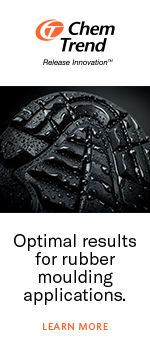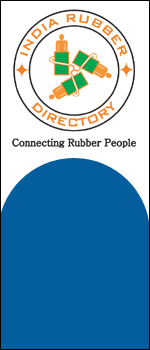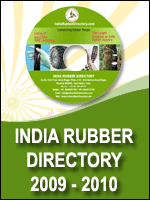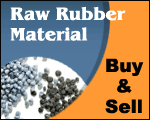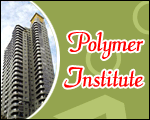|

|
|
IndiaRubberDirectory.com > Rubber Engineering > Vulcanisation |
Rubber Engineering-Vulcanising Agents And
Acceletrators
|
VULCANISING AGENTS AND ACCELERATORS
E.V. Thomas
Vulcanisation is a chemical process of inter-linking rubber molecules to change the predominantly plastic properties of rubber to elastic properties. Sulphur was the only vulcanising agent used in rubber industry during earlier years. With the discovery of synthetic rubbers it of these agents are now used as substitute for sulphur even in natural rubber.
Vulcanisation was discovered by Charles Goodyear in 1840. His experiments showed that mixture of rubber and sulphur when heated gave a hard tough material. This discovery materials to a variety of products. The prominent place of rubber as an industrial material is mainly due to the discovery of Vulcanisation.
During earlier days rubber and sulphur alone were used for Vulcanisation. Then the time of Vulcanisation was 8 hrs at 141░C. In a typical recipe 8 parts 'S' was present for 100 parts rubber. It was later found that metallic oxides reduce curing time. Still later it was observed that there are organic chemicals which can bring down time of
Vulcanisation to appreciably low levels. Thus the time of Vulcanisation of 8 hrs. When rubber and 'S' alone were present and got reduced to 30 minutes when specific organic chemicals which bring down time of Vulcanisation are called 'accelerators'. In this article, a short account of the different vulcanising agents and the dosage of them used in different vulcanising agents and the dosage of them used in different rubber will be included. Mantion will also be made on the use of different categories of accelerators in vulcansation.
Sulphur Vulcanisation:
Almost hundred percent of the commercial products of natural rubber (NR) and Styrene Butadiene rubber (SBR) are vulcanised using sulphur. The relative sulphur requirements in natural and synthetic rubbers vary. The quantities of sulphur used in common elastomers for Vulcanisation are given below.
NR -
1.75 - 2.75 Phr
SBR -
1.50 - 2.0
NBR -
1.0 - 2.0
IIR -
1.0 - 1.5
IR
- 1.5 - 2.75
BR -
1.0 - 1.5
Addition of sulphur in excess of the level mentioned above can cause blooming of sulphur. In order to prevent blooming part of normal sulphur is replaced with insoluble sulphur in the formulation. In semi EV, EV and sulphurless Curing, the proportions of sulphur used are 0.8 to 1.5 phr. 0.3 to 0.8 phr and 0.3 phr respectively. Normal sulphur Vulcanisation produces ploy sulphide cross links, and low
Sulphur and sulphurnless cure mono and disulphidic cross-links. The proportion of sulphur added to each elastomer a depends on the solubility of sulphur and the quality depends on the solubility of sulphur and the quality of the product to be produced from the particular compound. Generally as the proportion of sulphur increases, the tensile strength elongation at break and resilience increases and the agingproperties decrease.
Natural rubber shows reversion on over curing. Because of this a rubber simple will show decline in its physical properties when it is heated beyond the optimum cure time. SBR does not show any reduction in tensile strength on overture; it remains approxim lately constant. Nitrile rubber shows curing property improves after prolonged heating. Buty I rubber possesses little unseturation and hence more active accelerators are used in its Vulcanisation. Buty 1 shows tendency for reversion. Sulphur is less soluble in buty1 than in other rubbers and so quantity of the order since buty1 is a saturated polymer. It is necessary to select with curing agents. Pine tar, wood resin, facatice and unsaturated acids are therefore not very suitable in buty1 compounding. The cure of EPDM is very similar to that of buty1. The level of unsaturation is low.
Other vulcanising agents:
Slenium and Tellurium: For better heat resistance and for high modulus, these agents are used.
Sulphur donors:
Thiuram disulphide, dimorpholy1 disulphide, Di pentamethylene th iuram tetra sulphide.
Advantages:
Reduces blooming, confers processing safety. Only mono and disulphidic cross links are formed and so heat resistance is shown by vulcanisates.
Dosage:- TMTD 2.5 - 3.5 phr
Dimorpholy1 disulphide 1.5 -2.5 phr
Thiruam tetre sulphide (DPTS) 1.5 - 2.5 phr.
Sulphur Chloride S2cl▓
This is used mainly for the Vulcanisation of thin articles at room temperature.
Metallic Oxides:
Metallic oxides are necessary for vulcanising chloroprene rubber (CR). Most often used is a combination of zinc oxide and magnesium. Here zno is he cross-linking agent and Mgo is the acid acceptor. Non sulphur modified CR needs special accelerators like 2-mercapto imidazoline. Mgo is added first and zno is added last to avoid tendency for scorch.
Dosage Mgo - 4 phr
Zinc Oxide - 5 phr.
By raising the concentration of Mgo to about 10 phr higher plasticity and better storage stability are abstained. It also reduces rate of vulcatisation. By increasing zinc oxide the rate of Vulcanisation can be increased.
Epoxy resins:
Hypalon (Chloro-Sulphonated polyethylene) is vulcanised. With Epoxy resins. Epoxy resins give higher processing safety, shorter compounding time and good physical properties.
Dosage-Eenzoquienone resins: 10-15 phr.
Quinone dioxime:
Used as corss linking agent in buty1 rubber. It gives good heat resistance. To give good heat resistance, large amount of zinc oxide also is added.
Dosage - Eenzoquinone dioxime: 1.5 -2.5 phr
peroxidese
Peroxides are used in the Vulcanisation of silicon rubber other synthetic rubbers like EPLM, EVR, Polly urethane, Acrylate rubber etc. are also vulcanised with peroxides. Thus peroxides used in Vulcanisation are:-
(a) Di-tert buty1 peroxide
(b) Di-cumy1 peroxide
(c) Di- benzoy1 peroxide.
Vulcanisation with peroxide can only be accelerated by raising the temperature. Inclusion of stearic acid reduces cross-link yield and should therefore be dispensed with as far as possible.
Polymer Peroxide
Dosage
phr
Silocon
Dicumy 1peroxide
5-7
EPDM Ditert buty1 peroxide
5-7
EVA Ditert buty1 peroxide
5-7
Poly Urethane Dicumy 1 peroxide
5-7]
Acrylate rubber (a) Dibenzoy1 peroxide
1-2
(b) Dicumy 1 peroxide
1-2
Accelerator for Vulcenisation:
Accelerators are used in rubber industry to increase the speed of vulcanisation reaction. Without accelerators, vulcanisation is a very terdious and time consuming process.
Sulphur exists as an S8 ring and is relatively stable.
To make sulphur reactive a considerable amount of activating energy must be expended and the sulphur ring must be split. The process of activation occurs at high temperature and be promoted by certain organic substances which are called accelerators.
A good accelerator should have the following properties.
(a) It should give flat cure
(b) Should provide scorch safety
(c) Should give good storage properties for the uncured compound (bin cure)
(d) Should give good physical properties to vulcanisates.
It was known to scientists that natural rubber contained some substances
Which accelerate the process of Vulcanisation. Later it was proved that metallic oxides can increases speed of Vulcanisation. The first organic accelerator for Vulcanisation was used in 1906 by Oenslager. It was also found by activated by zinc oxide and fatty acid.
Accelerators are broadly classified into basic and acidic accelerators. The basic type includes (a) aldehyde ammine condensate (b) guanidine and this carbanilide. Acidic accelerators are classified according to presence of functional groups in them.
Acidic Accelerators:
1. Dithio Carbamates: These are salts of Carbamic acid H2 N - C-SH
Normally "N" alky1 substituted carbamic acid salts are└ ┬ └
Used as accelerators. S
a. Ammonium dithic cerbamates
Very scorchy accelerator. It is used for self-vulcanising compounds and solutions, fast curing rapair stocks, dipped goods, fabric processing, latex compounds etc.
Dosages - 0.25 - 0.75 phr
b. Zinc diethy1 dithio carbamate (ZDC)
This is the most important dithiocarbamate accelerator. It has a slower rate of cure than the ammonium salt. It is particularly suitable for hot air and steam Vulcanisation.
Dosage - 0.5-0.8 phr
Very small addition of TMT, MBTS and retarders raises processing safety and improve storage stability. The rate of Vulcanisation can be raised considerable by addition of ammonium dithio Carbamates or amines. In small amounts ZDC is a good activator for thioazole accelerators.
ZDC is used alone or in combination with other accelerators for transparent and brightly coloured rubber goods.
c. Seleneium and Tellurium dithic Carbamates:
these are used for special applications only as they and very costly. Generally they are used as accelerators or as additional accelerators of Buty 1, Hypalon and Ethylene/Propyleneter polymer.
Vulcanisation
Agents& Accelarators
|










